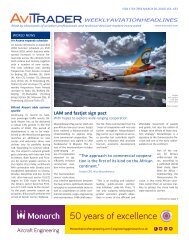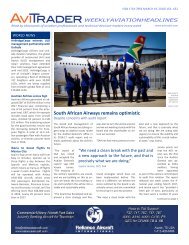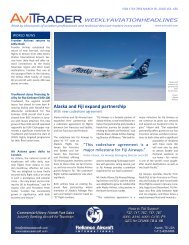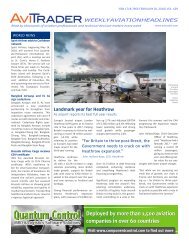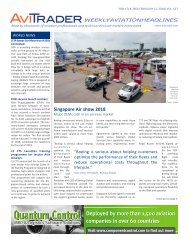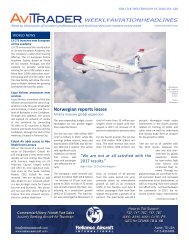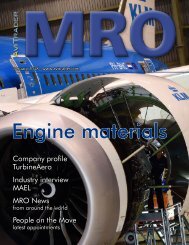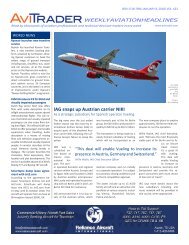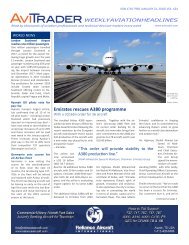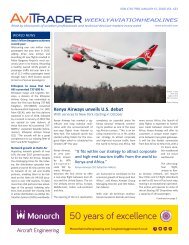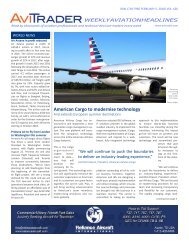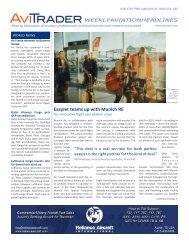AviTrader_Monthly_MRO_e-Magazine_2015-06
AviTrader_Monthly_MRO_e-Magazine_2015-06
AviTrader_Monthly_MRO_e-Magazine_2015-06
You also want an ePaper? Increase the reach of your titles
YUMPU automatically turns print PDFs into web optimized ePapers that Google loves.
ICF Opinion<br />
29<br />
Aircraft Spares – Demand, supply and value trends<br />
Analysis by John Mowry, Global Managing Director - Aviation Consulting & Services – ICF International.<br />
ICF estimates that airlines, distributors, <strong>MRO</strong>s, OEMs, and traders in the commercial aviation industry hold approximately $50<br />
billion in spare parts inventory, which compares to a commercial jet fleet valued at around $600 million. The majority of the<br />
inventory holdings, as measured by value, are held in the rotable/repairable part classes..<br />
In this article, ICF explores the factors affecting supply and demand, and resultant value trends, for various classes of spare parts.<br />
Aircraft Spare Parts Demand & Supply<br />
Spare Parts Demand<br />
Demand for aftermarket aircraft parts is tied directly to the utilisation of the aircraft that the spare parts support: the greater<br />
the utilisation, the greater the wear on the components, resulting in more frequent part replacements, repairs, and overhauls.<br />
John Mowry,<br />
Global Managing Director -<br />
Aviation Consulting &<br />
Services, ICF International.<br />
ICF projects the global fleet of commercial aircraft is set to grow from nearly 27,500 at the end of 2014 to nearly 38,000 by 2024 at an annual growth rate of<br />
3.2%. As this fleet grows and aircraft continue to age, global maintenance, repair and overhaul (“<strong>MRO</strong>”) spending is forecast to increase at a slightly faster<br />
rate of 3.8% per year: from USD $62.1 billion at present to $90.1 billion by 2024 (in 2014 USD).<br />
<strong>MRO</strong> Segment Assessment<br />
Engine maintenance accounts for the largest<br />
share of <strong>MRO</strong> expenditures, at approximately<br />
40% of the total, followed by components at<br />
23%. Line and airframe maintenance account for<br />
18% and 14% of <strong>MRO</strong> expenditures respectively.<br />
Engine overhaul is a material-intensive activity<br />
(principally repairable and expendable parts),<br />
whereas line maintenance and airframe heavy<br />
maintenance are mainly labour-driven, supported<br />
by expendable parts. The cost structure for<br />
component <strong>MRO</strong> varies by technology and ATA<br />
chapter, but is on average 50% material, 35% labour<br />
and 15% outside services. Projected growth<br />
rates over the next decade are anticipated to be<br />
robust across the largest volume and materialintensive<br />
engine and component segments.<br />
Aircraft Generation Assessment<br />
Current <strong>MRO</strong> demand is largely generated by<br />
new (e.g. Airbus A320 Family / Boeing 737NG)<br />
and mature generation aircraft (e.g. Boeing 747-<br />
400, 757, 767). However, as next generation,<br />
models are delivered (e.g. Airbus A380, A350X-<br />
WB, A320neo, and Boeing 787,737 MAX) and<br />
older models retire, the <strong>MRO</strong> demand will shift.<br />
Spare Parts Supply<br />
Trends in the supply of spare parts differs materially<br />
depending upon the part class.<br />
<strong>AviTrader</strong> <strong>MRO</strong> - June <strong>2015</strong>





